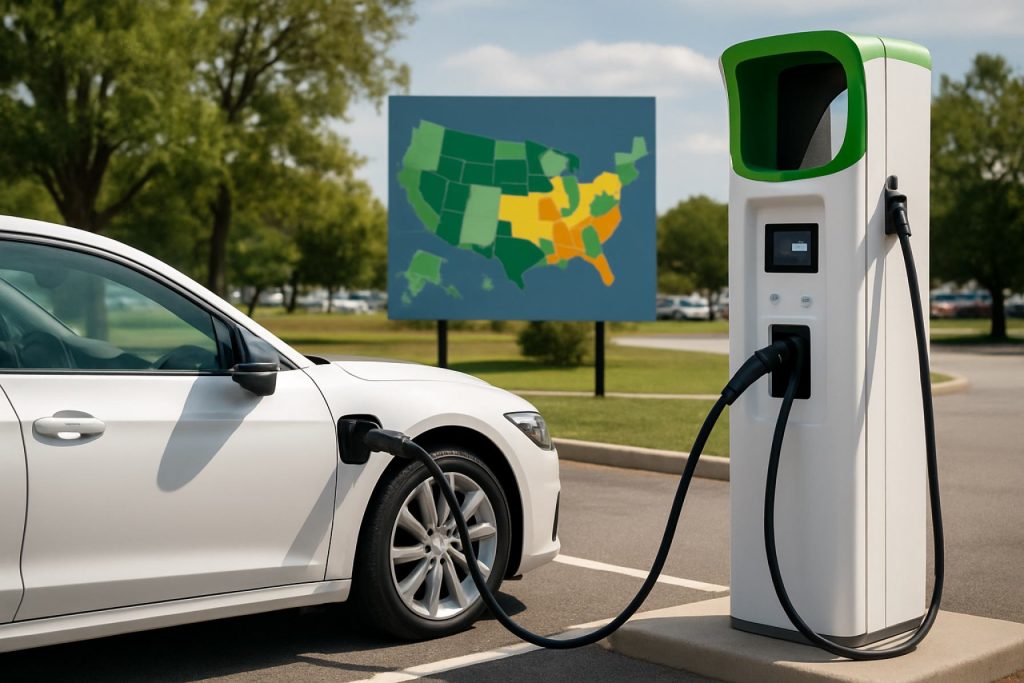
- Nearly 200,000 public EV charging ports operate across the U.S., with thousands added monthly, transforming travel for electric vehicle drivers.
- Achieving national EV infrastructure goals remains a challenge, with over 2 million charging stations needed by 2030 to meet projected demand.
- States like Delaware, Washington, DC, and Massachusetts lead in charging access, offering abundant, high-speed stations and generous incentives.
- States with minimal rebates and outdated charging infrastructure, such as Alaska and Arkansas, rank lowest and hinder EV adoption.
- Robust incentives, such as installation rebates and state support, directly accelerate EV charging network growth and consumer adoption.
- Strategic energy policy and investment are key to building a future-ready EV infrastructure accessible to all Americans.
Rising interest in electric vehicles has ignited a nationwide sprint to build the future of transportation. Across the American landscape, networks of gleaming charging stations have begun to dot major highways, urban centers, and even some rural stretches. Yet beneath this progress lies a stark reality: not all states are accelerating at the same pace.
Nearly 200,000 public charging ports now hum across the U.S., with close to a thousand new ones lighting up every week, reshaping the travel experience for those who have opted out of gasoline forever. The demand, fueled by increasingly affordable EVs from brands like Tesla and BYD, is undeniable. But national aspirations still vastly outstrip current achievements. The White House’s ambitious goal—half a million chargers by 2026—remains tantalizingly out of reach, and experts at the National Renewable Energy Laboratory predict more than two million will be needed by 2030.
To pinpoint who leads—and who lags—in this race, researchers created an index, tallying not just the raw number of charging points, but also the speed and distribution of chargers, the share of electric vehicles humming along local roads, and how crowded charging stations are likely to become.
Delaware, a diminutive state with outsized vision, claims the top spot for EV infrastructure. A seamless scatter of high-wattage charging stations—plentiful and powerful—keeps the state’s drivers gliding effortlessly from city to shore. Close behind, Washington, DC, Massachusetts, and Nevada have carved out charging corridors that are both convenient and quick. The Northeast, with its progressive policy and metropolitan density, dominates the top 10, while California, a long-reigning tech titan of the green movement, still clings to a robust showing.
Meanwhile, the permafrost of Alaska’s infrastructure—chilled by minimal utility rebates and scant government support—anchors the bottom of the leaderboard. Arkansas offers paltry incentives, and other lagging states like Idaho and Nebraska feature sparse, outdated stations where lines form and patience is tested. Here, the journey for EV drivers grows unpredictable, even precarious.
But incentives fuel ambition. Where robust rebates flourish, so do charging networks. In Washington, DC, drivers can halve their charger installation costs, sometimes recouping up to $10,000—money that draws more participants into the electric fold. New York’s extensive patchwork of more than 19 incentive options serves as another beacon, offering tailored support for communities and building types. Even at-home chargers are accelerating adoption, and more than half of all states now extend rebates for residential installations, averaging $534—helping to lighten the public load.
The message flashes clear: Smart energy policy and targeted investment drive real change. States that couple ambition with support are not just preparing for, but actively building, the electrified future. As affordable EVs prepare to stream in from global manufacturers, only a proactive embrace of infrastructure will ensure drivers—new and veteran alike—find the road ahead open, charged, and ready.
Takeaway: The electric vehicle revolution is steadily rolling forward, but its reach into every corner of America depends on bolder incentives, smarter networks, and a commitment to make charging as easy as plugging in a phone. The future belongs to the fast—and the prepared.
EV Charging in America: Why Location, Policy, and Innovation Mean the Road Trip of the Future Starts Now
EV Charging Infrastructure: Fresh Insights, Useful Tips, and Industry Trends
The electric vehicle (EV) landscape in the United States is evolving at breakneck speed. While the source article highlights new public charging stations and state-by-state advances, there are even deeper trends, facts, and practical insights vital to understanding where the EV revolution is heading and how consumers, businesses, and policymakers can stay ahead.
Key Additional Facts
EV Charging Types & Compatibility
– There are three main types of EV charging:
– Level 1: Standard 120V wall outlets; slowest (adds ~2–5 miles/hour).
– Level 2: 240V; the most common for home and public use (adds ~10–60 miles/hour).
– DC Fast Charging: High-speed (adds 60–200+ miles in 20–30 mins), crucial for highways.
– Not all EVs are compatible with every fast charger; for example, Tesla has its proprietary Supercharger network, but is expanding support for non-Tesla vehicles (source: Department of Energy).
– Combo/CCS and CHAdeMO are primary non-Tesla standards, but the North American Charging Standard (NACS) is quickly gaining ground.
How-to: Installing a Home Charger
Want to maximize convenience? Here’s how to get started:
1. Check your EV’s plug type and amperage needs.
2. Review local and federal incentive programs (find state options at energy.gov).
3. Hire a licensed electrician for safety and code compliance.
4. Register your installation with your utility; some offer time-of-use rates for overnight charging.
Security & Sustainability Insights
– Modern chargers increasingly include cyber protections; however, the White House (2023) flagged cybersecurity as a major vulnerability in public networks.
– Renewable energy integration is growing; companies are developing solar-powered charging canopies (e.g., Electrify America’s solar-backup sites).
– Sustainability isn’t just about the electricity source—EV charger production, siting, and end-of-life recycling are part of a greener future (source: International Energy Agency).
Market Forecasts & Industry Trends
– U.S. EV market expected to reach over 1.5 million annual sales by 2025 (source: BloombergNEF).
– Wireless (inductive) charging and “battery swap” stations are pilot-tested in select regions, offering faster recharge possibilities.
– Automakers like Ford, Hyundai, and GM now building in NACS support for broader charger access.
Common Questions Answered
Q: What happens when the grid is under strain—will EVs still charge?
A: Many utilities offer managed charging; owners may be encouraged (or automatically scheduled) to charge at off-peak times, easing demand.
Q: Are all public chargers reliable?
A: Reliability can be an issue: recent J.D. Power studies report 20%+ failure rates at some fast-charging locations. Always check real-time status with apps like PlugShare or ChargePoint.
Q: Which states offer the best incentives for EV charging infrastructure?
A: New York, California, and Colorado are regularly cited for top-tier state-level programs (e.g., rebates up to $4,000 per home install, business credits, and low-income aid).
EV Charger Reviews & Comparisons
– Top L2 home chargers: JuiceBox 40 ($599), ChargePoint Home Flex ($699), Tesla Wall Connector ($475). All support WiFi/app control and scheduled charging; Tesla’s is most cost-effective for Tesla drivers.
– Public network review: Electrify America and ChargePoint lead in station count and speed, but Tesla’s Supercharger network scores highest for reliability and ease of use.
Pros & Cons Overview
Pros:
– Lower fueling costs (~50% less per mile vs. gasoline).
– High-performance, lower maintenance.
– Ability to “refuel” at home.
Cons:
– High initial vehicle and charger cost (offset by incentives).
– Infrastructure gaps in rural/interstate regions.
– Charging speed varies widely by station and vehicle.
Life Hacks for EV Owners
– Use route planners (A Better Routeplanner, PlugShare) for seamless long trips.
– Enroll in utility Time-of-Use programs for off-peak charging and save up to 30%.
– Leverage stacking rebates: federal + state/local can cover most or all charger costs.
Controversies & Limitations
– Some critics argue that federal funding distribution favors urban corridors, leaving rural America underserved.
– Reliability, downtime, and charger “ICEing” (ICE vehicles blocking EV spots) reported as ongoing annoyances.
– Power grid readiness lags behind projected demand in multiple states.
Industry Insights & Predictions
– Expect massive charger expansion in next 24 months as NEVI (National Electric Vehicle Infrastructure Program) funds roll out.
– Watch for major automaker partnerships—Ford and GM already integrate public fast charging in navigation systems.
– “Plug and Charge” standards (ISO 15118) will someday allow automatic payment, ending card swipes and apps.
Actionable Quick Tips
– Use tax incentives and rebates now—funds are limited and early applicants get priority.
– When choosing your EV, consider range, plug compatibility, and local station density.
– If you live in an incentive-rich state, go for a Level 2 home charger to future-proof your setup.
– Regularly update car and app firmware to benefit from improved charging network integration and reliability.
Bottom Line
Even as some states race ahead and others stall, strategic planning, informed purchases, and policy advocacy will maximize your EV experience and help propel a sustainable, reliable, and accessible charging landscape.
For more information on federal programs and to check incentive eligibility, visit the U.S. Department of Energy.



